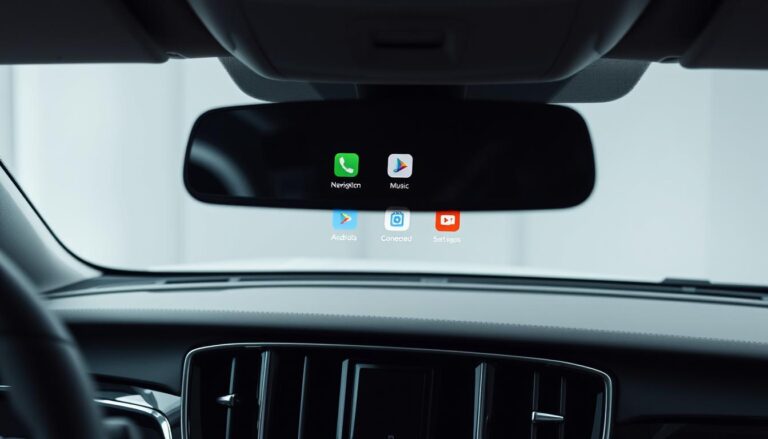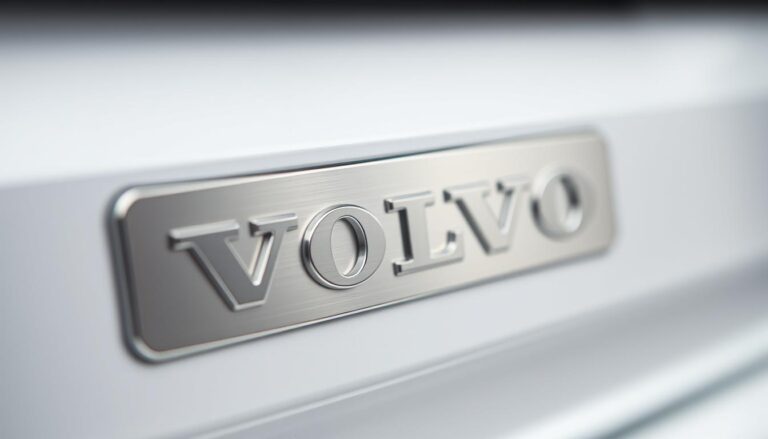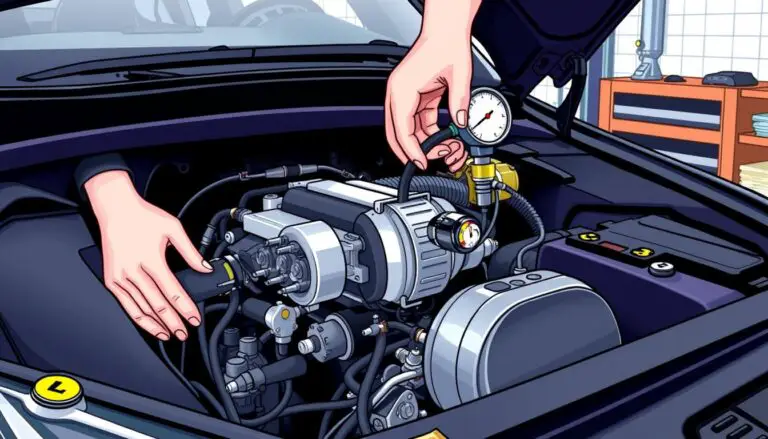This buyer’s guide answers the core question about lifespan and what affects it across different powertrains in U.S. ownership. Expect clear details on 12V service life, high-voltage packs, and practical steps to avoid no-start surprises.
Typical 12V units in many models run about three to six years, with dealerships commonly citing three to five years. Climate, driving patterns, and maintenance change that range.
High-voltage packs in plug-in hybrid and electric models are built to serve the vehicle life and come with an eight-year, 100,000-mile warranty. This guide covers main 12V units, start/stop and AGM options, and high-voltage packs.
We preview signs of wear, diagnostic steps, and when a battery replacement makes sense. You’ll also find cost ranges, reasons prices vary by model year and equipment, and tips to extend service life.
Key Takeaways
- Most 12V packs last several years; weather and use matter most.
- EV and PHEV high-voltage packs are engineered for long life and include strong warranties.
- Learn simple diagnostics to spot wear before a no-start event.
- Replacement costs vary by model, year, and features.
- Proactive maintenance extends service life and reduces surprises.
Buyer’s Guide Overview: Volvo Battery Life, Replacement, and Service Options in the U.S.
If you own a Volvo cars model, plug-in hybrid, or EV in the U.S., this guide maps out service choices and timing for battery care.
Who benefits: Owners seeking clear information on battery life, battery replacement timing, and where to get reliable service will find practical steps and contact options.
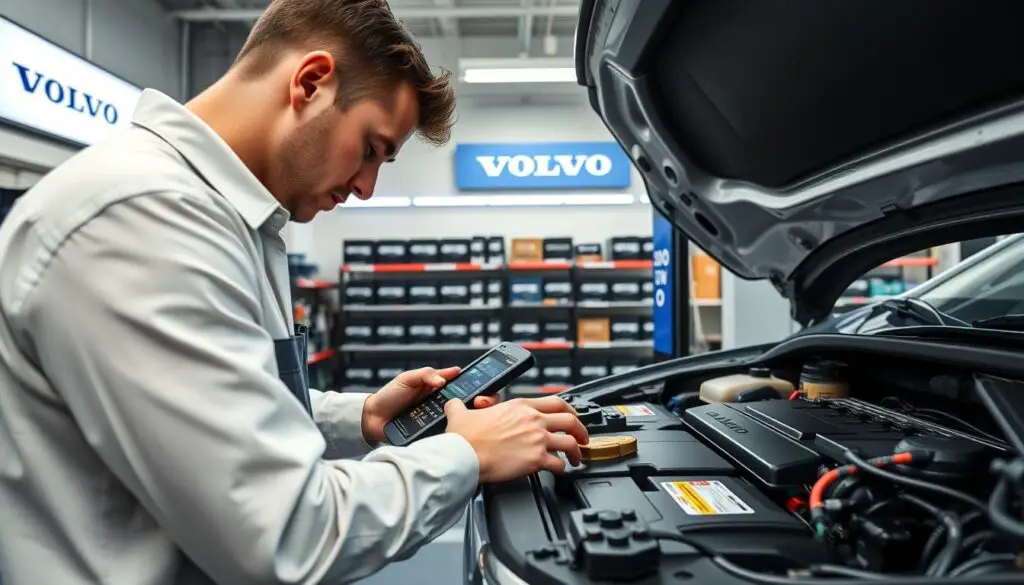
Dealership service teams use targeted diagnostics to pinpoint charging-system or battery faults. That reduces guesswork and often shortens repair time.
“Dealerships offer OEM parts, multi-point inspections, and transparent estimates to help owners plan repairs.”
At a service center today expect inspection, battery testing, and a parts fitment check. Some models include a secondary auxiliary unit for start/stop; technicians test and replace it separately as needed.
- Online scheduling and current specials speed appointments.
- Fitment depends on model, trim, and year; verified parts maintain safety.
- Nationwide dealer coverage helps owners get service and honest estimates quickly.
| Service | What to Expect | Typical Result |
|---|---|---|
| Diagnostic Check | Battery and charging test | Clear fault report |
| Auxiliary Test | Start/stop unit inspection | Separate replacement if needed |
| Parts & Repair | OEM parts sourced | Proper fit and warranty |
Use official centers or reputable shops to ensure correct installation and peace of mind. Explore volvo resources for verified information and set an appointment today.
How Long Do Volvo Batteries Last
Expect most 12V units to run about three to six years in normal use. Dealerships often report three to five years, while real-world data can stretch to four to six depending on climate and electronics load.
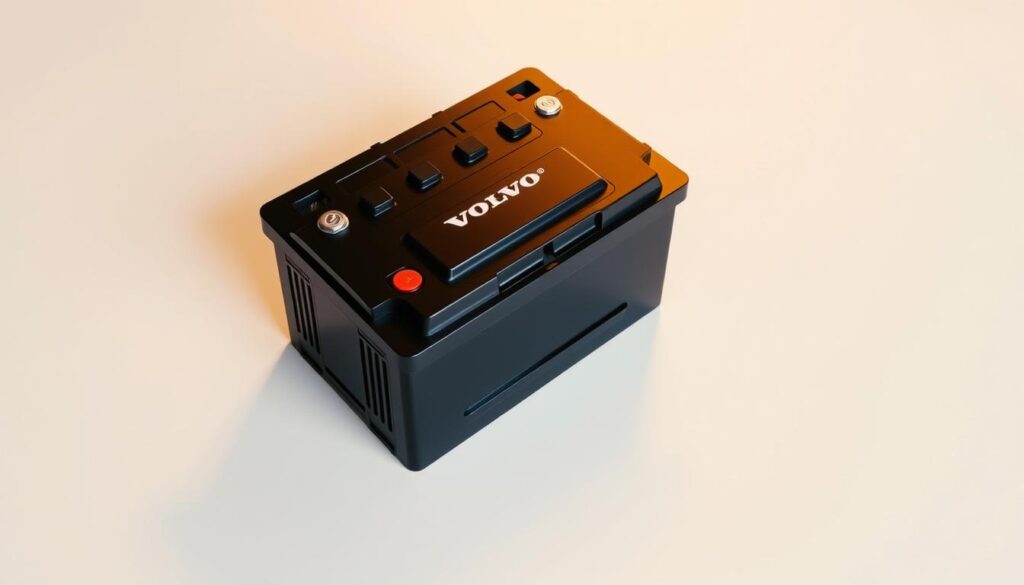
Typical 12V lifespan and daily use
Cold weather, extreme heat, frequent short trips, and heavy accessory use shorten service time. A newer car with more features may tax the battery and reduce expected years in service.
High-voltage pack expectations
High-voltage packs in hybrid and electric models are engineered for vehicle life and come with an eight-year, 100,000-mile warranty. This coverage is separate from the small 12V system.
- Factors that affect life: electronics load, alternator health, storage conditions, and frequent start-stop cycles.
- Periodic testing catches early capacity loss and helps avoid a no-start event.
- Top-up charging on cars that sit and basic maintenance extend service time.
Volvo Battery Types Explained: Main 12V, Start/Stop Auxiliary, AGM, and High-Voltage Packs
Modern Volvo models use several battery types, each designed for specific vehicle functions and electrical loads.
Main 12V battery functions
The primary 12V unit is an SLI battery that handles starting, lighting, ignition, and powering infotainment and other accessories.
It supports critical vehicle systems when the engine is off and stabilizes voltage while driving.
Why some vehicles have two batteries
Many models include an auxiliary battery dedicated to start/stop. That unit restarts the engine at stops and reduces fuel use and emissions.
A dashboard message such as “Start/Stop Service Required” often points to the auxiliary battery and suggests inspection by a qualified shop.
AGM vs. conventional lead-acid
Newer cars frequently specify AGM batteries to meet higher electrical demands and start/stop cycling. Older models may use conventional lead-acid units.
Choosing the correct type matters: using the wrong part can trigger warnings or cause premature failures.
Hybrid and EV systems
Hybrid and electric models like volvo ex90, ex30, and XC40 Recharge use large high-voltage packs that are separate from the 12V system.
High-voltage packs require different charging strategies and active thermal management compared with a standard 12V battery.
| Battery Type | Primary Role | Typical Use Case |
|---|---|---|
| Main 12V | Start, lights, accessories | All cars for ignition and electronics |
| Auxiliary (Start/Stop) | Engine restart at stops | Vehicles with stop-start systems |
| AGM | Higher discharge and recharge cycles | Newer trims with heavy electrical load |
| High-voltage pack | Propulsion for hybrid/EV | EX90, EX30, XC40 Recharge and similar |
What Impacts Volvo Battery Lifespan and How to Maximize It
Everyday driving choices and simple storage habits have a big effect on a car battery’s usable years. Small actions add up, and many factors are within an owner’s control.
Driving habits, short trips, and charging system health
Frequent short trips and stop-and-go driving often prevent a full recharge and shorten battery life. Running many accessories during short drives increases drain and wear.
Check the charging system — alternator and belt problems can mimic battery issues and speed degradation. Have charging tested before replacing parts.
Weather extremes and storage
Heat and cold stress batteries. Park indoors or in the shade when possible. If a car sits unused for long periods, start or drive it regularly to avoid deep discharge.
Maintenance tips and system load
Clean corrosion from posts and terminals, keep the battery tightly fastened, and test capacity periodically. Modern features like heated seats, infotainment, and advanced safety systems raise power demand and can tax the battery more than older setups.
- Inspect terminals and clean buildup to prevent charging issues.
- Schedule battery tests before seasonal swings to catch problems early.
- Use OEM parts and routine service checks to avoid unexpected failures.
Signs You Need a Volvo Battery Replacement and How to Diagnose
Small warning signs in your dash or accessories can point to an underperforming battery long before a breakdown.
Common warning symptoms include a battery light, hard starting, clicking when you turn the key, and interior lights that dim or won’t work.
Electrical glitches such as flickering headlights, a black or non-responsive display, or alarms and locks that misbehave are early indicators. A dashboard message like “Start/Stop Service Required” often signals an auxiliary battery issue, not the main unit.
- Slow cranking or repeated hard starts point to the starting circuit or battery needing attention.
- Flickering displays and intermittent accessories warn of declining capacity.
- Low battery alerts can come from a weak battery, BMS reset, or heavy device charging; testing finds the cause.
| Symptom | Likely Cause | Shop Diagnostic |
|---|---|---|
| Clicking at start | Low cranking voltage | Load test and voltage check |
| Black display / flicker | Weak battery or parasitic draw | Battery capacity test and parasitic draw test |
| “Start/Stop” alert | Auxiliary battery or sensor fault | Aux battery test and system scan |
Seek professional service if the car struggles to start, locks or alarms fail, or multiple anomalies appear. Proper diagnosis prevents unnecessary replacement and protects sensitive electronics.
Costs, Warranty, and Choosing the Right Replacement at a Volvo Service Center
Expect variable cost estimates when you need a 12V unit swapped. Prices depend on model, battery type, and how easy the unit is to access. Dealers and independent shops offer different price bands and service options.
Typical costs and what to expect
Most 12V replacement services fall roughly between $45 and $350 before tax. Some dealerships list $45–$250 while others quote $75–$350 depending on spec.
Labor can add about $20–$40 when access is straightforward. Larger SUVs like the xc90 often need extra time and parts due to tighter layout or auxiliary units.
Hybrid and EV considerations
High-voltage packs for hybrid and electric models are far costlier to replace. They are, however, covered by an 8-year/100,000-mile warranty in most cases.
Routine 12V needs still apply even on hybrid and EV vehicles, so plan for periodic checks.
OEM parts, specials, and service advice
Choose OEM-type parts to match specs and protect electronics. Ask your service center about parts and service specials to reduce out-of-pocket cost.
| Item | Typical range | Notes |
|---|---|---|
| 12V battery replacement | $45–$350 | Model and type affect price |
| Labor | $20–$40 | Tight bays add time |
| High-voltage pack | Considerably higher | Usually under warranty (8yr/100k) |
Recommendation: Verify warranty terms, confirm the correct type and fitment with your advisor, and address charging-system issues during the same visit to avoid repeat replacement and extra parts costs.
Conclusion
Small, regular steps add meaningful life to a battery and reduce unexpected downtime. Most 12V units serve reliably for about three to six years, while auxiliary start/stop packs appear in many newer cars and models.
High-voltage packs in EVs and PHEVs are engineered for vehicle life and usually carry an eight-year, 100,000-mile warranty. Timely testing, clean terminals, and proper storage extend service time.
If you notice weak cranking or electrical glitches, schedule diagnostics to avoid a no-start event. Choose OEM-spec replacement and reputable installation to protect sensitive systems and preserve performance.
Explore Volvo service options, check local specials, and plan needed work today so your vehicles stay ready for daily use — from routine sedans to the EX30 EV.
FAQ
What is the typical lifespan of a 12V battery in a Volvo car?
A Volvo’s 12V battery generally runs about three to six years. Actual life depends on driving habits, climate, and how often the vehicle sits unused. Short trips and frequent start/stop cycles shorten service life; regular highway driving can extend it.
How long do high-voltage hybrid and electric packs last in models like the EX90 or EX30?
High-voltage packs are engineered to last the vehicle’s operational life and usually come with an eight-year/100,000-mile warranty in the U.S. Proper charging, climate control, and software updates help preserve capacity over time.
Why do some Volvos have two batteries?
Many Volvos use a main 12V battery plus an auxiliary battery to support start/stop systems and electronics. The secondary unit reduces load on the main battery and improves fuel efficiency and reliability for modern vehicle systems.
What’s the difference between AGM and conventional lead-acid batteries for Volvo models?
AGM (Absorbent Glass Mat) batteries handle deep cycling and high electrical loads better than traditional lead-acid types. Some Volvo models and start/stop systems require AGM for stable voltage and longer life, while older or base models may use conventional batteries.
What driving and environmental factors shorten battery life?
Frequent short trips, extreme heat or cold, long periods of inactivity, and heavy accessory use reduce battery longevity. Corrosion on terminals and a weak charging system also contribute to premature failure.
How can I maximize battery life in my Volvo?
Drive longer trips regularly, park in a garage when possible, avoid leaving electronics on while parked, clean and tighten terminals, and get periodic battery and charging-system tests at a Volvo service center.
What are common signs that a 12V battery needs replacement?
Watch for slow cranking, clicking when starting, dim or flickering lights, erratic infotainment behavior, and dashboard alerts such as “Start/Stop Service Required.” Door locks, alarms, or keyless entry failures can also indicate low battery health.
When should I bring my Volvo to a service center for battery testing?
Schedule diagnostics if you see warning messages, notice hard starts, or after three years of service. Certified Volvo technicians can perform load and charging tests and advise on OEM replacements or upgrades like AGM units.
How much does a 12V battery replacement cost at a Volvo service center?
Typical replacement costs range widely, about to 0 for parts, depending on battery type (conventional vs. AGM) plus labor. Prices vary by model—XC90 and S60 repairs may be pricier due to system complexity.
What should owners know about hybrid and EV battery replacement costs and warranty?
High-voltage pack replacement can be expensive and involves complex diagnostics and labor. Many Volvo plug-in hybrids and electrics include an eight-year/100,000-mile warranty for the battery. Check your vehicle’s warranty and service offers before scheduling work.
Are OEM batteries preferable to aftermarket options?
OEM batteries match manufacturer specifications and software integration, reducing risk of compatibility issues. Aftermarket units can save money but verify compatibility, reserve capacity, and warranty before purchasing.
Can charging habits affect hybrid and EV battery health?
Yes. Regularly following recommended state-of-charge ranges, avoiding frequent full-charge extremes, and using proper charging equipment helps maintain battery longevity. Software updates from Volvo also optimize charge management.
How does heavy electrical load from features impact battery life in vehicles like the XC90?
Advanced infotainment, heated seats, climate control, and driver aids increase electrical demand. These systems can strain the 12V battery if the main charging system or auxiliary battery isn’t in good condition, making proactive maintenance important.
What maintenance steps should I perform to prevent battery issues?
Keep terminals clean and tight, secure the battery to limit vibration, test voltage and charging health annually after three years, and follow seasonal care—store the car charged in cold months and avoid long idle periods.
Where can I find specials or parts when replacing a Volvo battery?
Check authorized Volvo service centers for OEM parts, service specials, and certified technicians. Dealerships often run promotions on battery replacement and diagnostic services, and they can ensure proper programming and installation.

